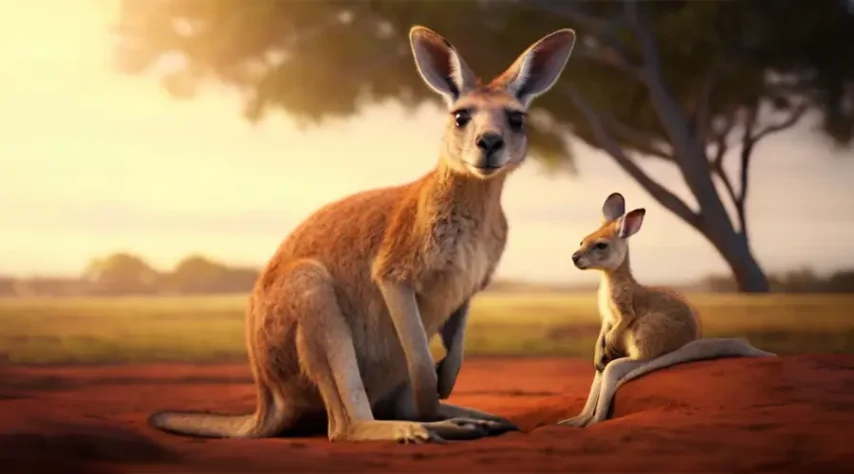In the enigmatic realm of the animal kingdom, the kangaroo stands out as a perplexing puzzle of parenthood. Indigenous to Australia and neighboring islands, kangaroos, classified as marsupials, present a captivating case study in evolutionary marvel. Their parenting techniques, particularly the utilization of the iconic pouch, have fueled intrigue among scientists and nature enthusiasts alike. This article endeavors to unravel the bewildering mystery behind why a kangaroo opts to carry its progeny in a pouch, inviting readers to plunge into the labyrinthine complexities of this extraordinary parenting stratagem.
The Marsupial Marvel:
Delving into the depths of the marsupial infraclass, kangaroos emerge as a peculiar subset marked by premature births and distinctive reproductive anatomy. Unlike their placental counterparts, which nurture fully developed embryos within the womb, marsupials opt for a different approach. The crux of comprehending the kangaroo’s parenting idiosyncrasy lies in untangling the intricacies of the marsupial reproductive process.

Upon conception, the fertilized egg within a female kangaroo metamorphoses into a diminutive, premature joey. In a staggering departure from conventional birthing norms, the underdeveloped joey emerges, often resembling a diminutive lima bean, embarking on a journey into the mother’s pouch. This pouch, essentially a convoluted fold of skin sporting a central opening, metamorphoses into a haven of protection, a cocoon for the vulnerable joey’s continued development.
The Pouch as a Protective Cradle:
The question looms: why does a kangaroo resort to such an elaborate and unique parenting strategy? The answer is embedded in the evolutionary brilliance of the pouch as a protective cradle. Serving as an impregnable sanctuary, the pouch shields the newborn joey from a myriad of potential perils, ensuring its survival amid the unforgiving Australian wilderness.
As the joey finds its way into the pouch, it instinctively fastens onto one of the mother’s teats, kickstarting a cycle of nourishment and growth. The pouch becomes a sanctum, a warm, enclosed space warding off predators, inclement weather, and other environmental threats. This unconventional parenting approach significantly heightens the likelihood of the joey’s survival during the precarious early stages of its existence.
Mobility and Maternal Care:
Adding another layer to the perplexing puzzle, the kangaroo’s pouch unveils its role in fostering maternal care and mobility. Renowned for their formidable hind legs, kangaroos possess the ability to traverse vast distances with unparalleled speed. The pouch becomes the linchpin, allowing the mother to transport her progeny while maintaining her agility and mobility—an invaluable asset in the wilderness.
The kangaroo pouch unfolds its ingenuity by dynamically adapting to the joey’s growth, ensuring an optimal fit as the offspring develops. This adaptability affords the mother the freedom to move adeptly, foraging for sustenance and eluding potential threats, all while affording ceaseless care to her offspring. The ability to transport the joey within the pouch is a living testament to the kaleidoscopic brilliance of evolution that propels kangaroos to thrive in their uniquely demanding ecosystem.

Parental Investment and Adaptation:
The kangaroo’s pouch transcends mere biological function, emerging as a poignant symbol of parental investment. In the intricate dance of evolutionary biology, this concept underscores the resources and efforts parents invest in raising their progeny. For kangaroos, the pouch becomes a tangible manifestation of maternal commitment, a reservoir of energy and resources meticulously allocated to ensure the perpetuation of their species.
The evolutionary brilliance of the pouch unfurls its wings when juxtaposed against the formidable challenges posed by the Australian environment. Vast arid landscapes, capricious temperature fluctuations, and an array of predators characterize the continent. The pouch, by extending a sheltered sanctuary for the joey, equips kangaroos with the tools needed to reproduce and raise their young successfully in this challenging milieu.
The Unique Physiology of Marsupials:
To fathom the enigma of the kangaroo’s pouch, one must traverse the labyrinth of marsupial physiology. A stark departure from the gestational norms of placental mammals, marsupials wield two uteri and distinctive reproductive organs integral to their unconventional reproductive methodology. The pouch, effectively an external extension of the uterus, facilitates direct contact between mother and offspring, cultivating an intimate bond during the critical embryonic stages.
The pouch’s functionality transcends the realms of protection and nourishment, extending into thermoregulation. This pivotal feature aids in maintaining an optimal temperature for the joey’s growth. The amalgamation of the mother’s body heat and the protective enclosure of the pouch creates a microenvironment conducive to the joey’s development, guaranteeing it receives the requisite warmth and comfort for its nascent existence.

Conclusion:
In navigating the intricate tapestry of nature, the kangaroo’s pouch emerges as a tapestry woven with the threads of evolution’s mysteries. The unorthodox parenting technique of cradling their young in a pouch has been a linchpin propelling kangaroos through the trials of the Australian landscape. The pouch metamorphoses into more than a protective cradle—it is a mobile nursery, a symbol of marsupial adaptability and evolutionary resilience.
As we stand on the precipice of unraveling the enigmatic mysteries shrouding the kangaroo’s pouch, we glean insights not just into the biology of these captivating creatures but also into the broader principles of evolutionary adaptation and profound parental investment. The next time a kangaroo bounds across the Australian outback, take a moment to contemplate the pouch-carrying marvel—an ode to the perplexing wonders of nature and the myriad strategies employed by diverse species to secure the survival of their kin.







